· 19 min read
UX Insights: Golfclash’s Swing To Success!

Om Tandon
Founder/Games Consultant at UX Reviewer.com.
Sport simulation games have been a massively popular genre in video games industry since the early 70’s. Many of you must have grown up playing franchises like NBA, FIFA, Ashes, Madden NFL, NFS, Football Manager, Tiger Woods – PGA and many more sports titles across PC and consoles.
“Real world sports games imbibe natural qualities like competitive rulesets, challenging opponents, strategy, skills & mastery that video games & gamers already subscribe to. This makes them a natural fit for a digital makeover.”
It’s no surprise that the top 10 – 50 grossing charts on mobile games also boast their share of sports simulation games.
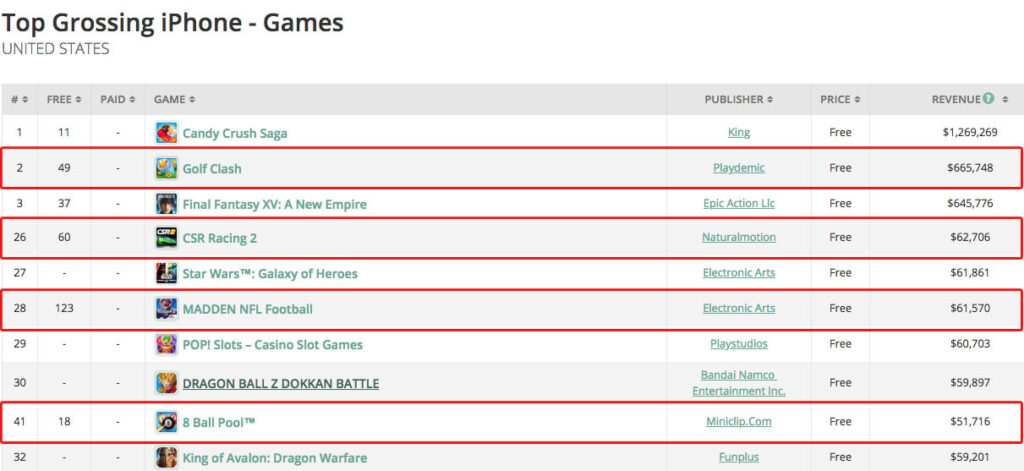
Source : ThinkGaming 2/03/2018
Mobile space is dominated by many sport titans which are either tactical or strategy based. There is a plethora of choices from basketball, cricket, football manager, golf and tennis to car racing. Heavyweights that dominate the top grossing charts are Madden NFL, Golfclash, 8 Ball pool and CSR 2 (a spin off of the genre).
But it’s the most recent addition of “Golfclash” that has shaken up the scene and made this category more mobile friendly, enjoyable and popular than ever before.
Golfclash
Golfclash by Playdemic became an overnight success since its launch. It has rapidly climbed the UK app store top grossing charts and is now a permanent fixture in US top 50 grossing, surpassing even all time favorite 8 Ball Pool.
Core Gameplay Experience
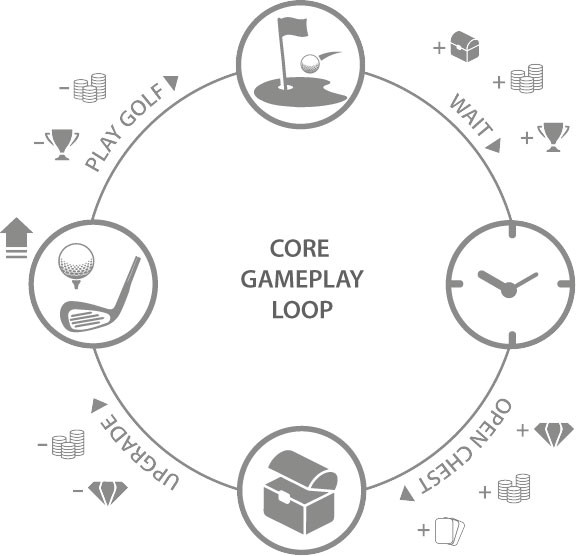
Core loop involves player placing wagers in PvP turn based golf matches, earning trophies and timed chests, setting them to unlock for rewards – coins, gems and club shards. Clubs can be upgraded with coins. Earning trophies and leveling up opens subsequent tours with increasing wagers, more difficult golf courses and experienced opponents.
Sounds familiar? At first glance you will see a lot of similarities between Clash Royale and Golfclash as the latter borrows heavily from formers’ free flowing menu design, chest unlocking mechanism, progression path and earning trophies to unlock the next Tour (Equivalent of Arena’s in Clash Royale). Apart from the core gameplay, Golfclash has simulated almost all mechanics from Clash Royale which is a big contrast to the many games that have tried to mimic clash Royale’s MOBA type gameplay and failed (like Star Wars : Force Arena).
Golfclash took a different path: It mimics every other feature except the core gameplay & this seems to be working out great for them.
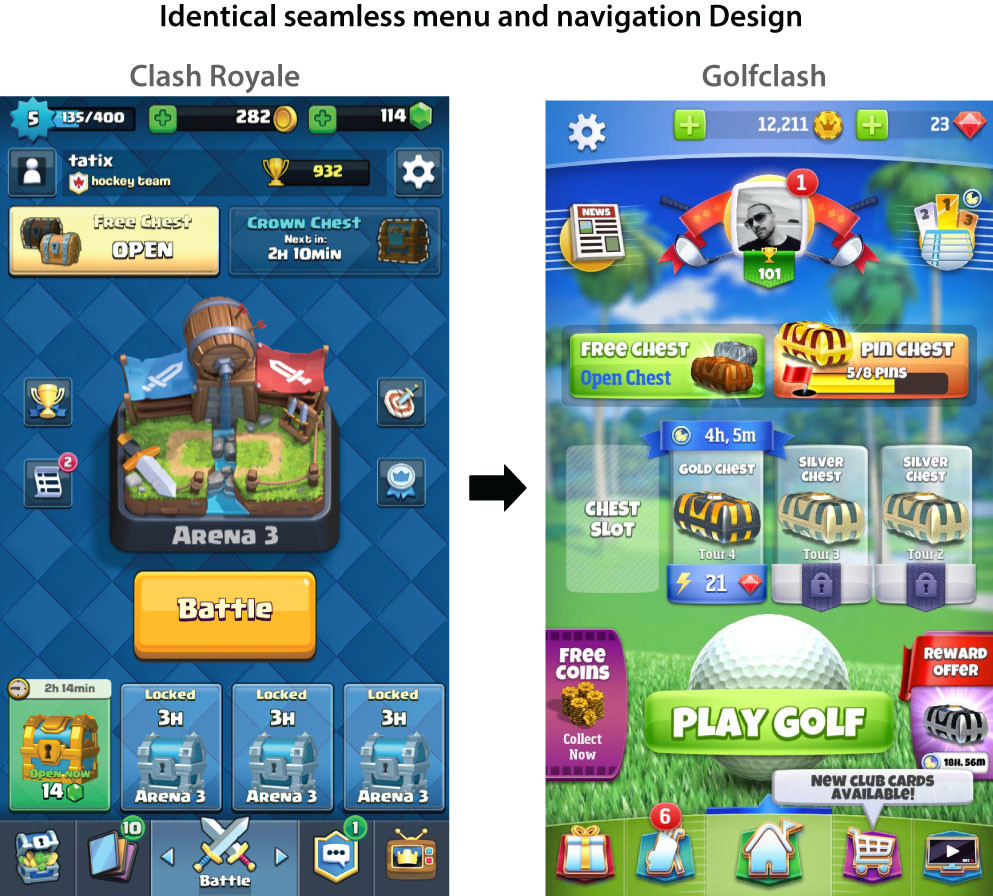
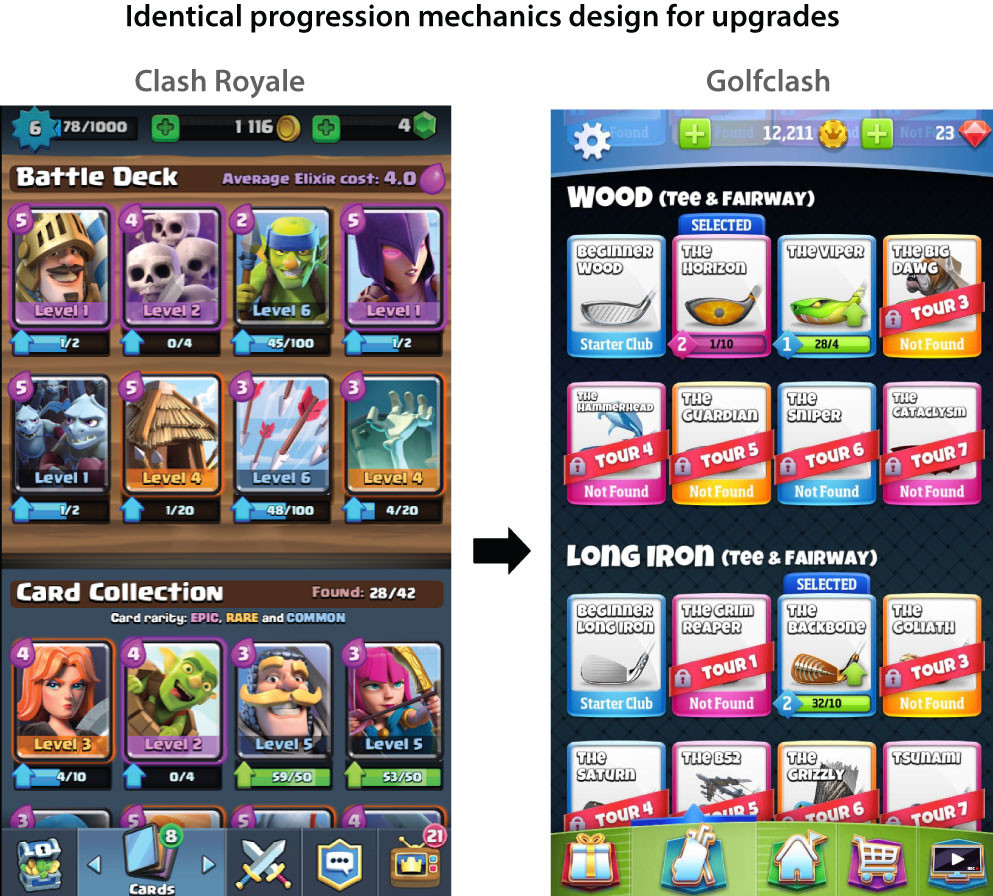
The mimicking choices are quite interesting; as though there are many ways Golfclash could have designed it’s progression, reward and menu features. But as I have written in an article earlier on Gamasutra, Clash Royale’s menu and flow design are a great example of a game that falls within casual mid-core space with its seamless transition from one tab to the other minimizing drill downs and wait times which is a refreshing experience compared to more prevalent lobby screens with multiple drill downs and load times flow in other games.
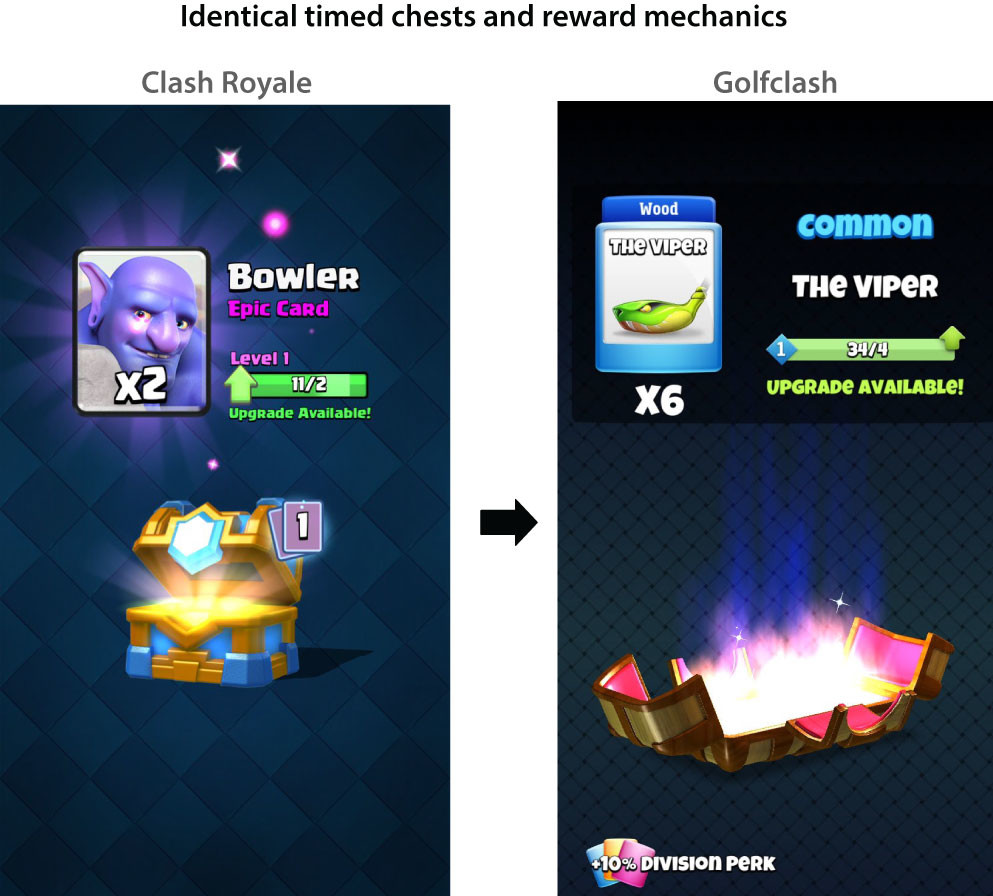
Golfclash, with its easy to follow navigation, on boarding, inventory management and progression system, is a breeze for casual players to pick up. However with the depth offered within the progressive difficulty level arena, mastery of factors that influence core gameplay like course obstacles, gear acquisition and upgrades has high appeal to mid-core player who are looking for more depth and challenge.
“Extremely easy to pick up but difficult to master.”
Given the success of Clash Royale and its ease of use and UX merits, it makes sense to follow an existing popular mental model (in terms of experience, mechanics and progression flows) which has been such a hit with both casual and matured gamers.
However the comparisons end right here!
To its full credit, Golfclash’s core gameplay design stands out on its own brilliantly in terms of accessibility, learnability and the right balance of handholding and mastery – which has a very broad appeal to engage and peak interest of both casual and more hard core gamers.
At first glance, if you think that Golfclash is an attempt on Clash Royale with a turn based gameplay variation, stick around & you will be proved wrong.
One of the cardinal rules contributing to success of any game is having a strong and engaging core and/or meta loop making the game sticky and engaging. Golfclash does it brilliantly as you can enjoy the game even if you don’t care about Golf at all!
Even if you are not an avid fan of golf or don’t know your tee from a fore, it’s still a breeze to pick up the gameplay.
Here is why:
Key Experience Highlights:
Excellent guidance and hand-holding system
Golfclash’s guidance system in part follows closely the perfect timing shift mechanics you find in games like CSR2.

Similar to CSR 2 where players need to time the alignment of the arrow with color coded accuracy zones, players can achieve different degree of accuracy in their gear shift like Perfect, Good, Late etc. Golfclash uses a similar sling system, holding and releasing the ball (as shown below). Aligning the ball correctly with the movement of the arrow at the perfect time increase your chances of releasing different degrees of precision shots like Great, Perfect, Sliced etc.

But unlike CSR2 applying the precision sling system blatantly does not means you will get the best or optimal outcome. For example you may pull off a great shot but it may end up “in the rough” or in a sand pit. So even though by following the precision system one can get optimal shots, players learn over time that they can increase their odds of getting better results by adjusting other parameters like landing a ball closer to the hole or reticle, gauging golf course design to avoid obstacles, wind speed, and to a lesser extent ball type and putt’s characteristics can have an impact on your performance and every single shot you take.
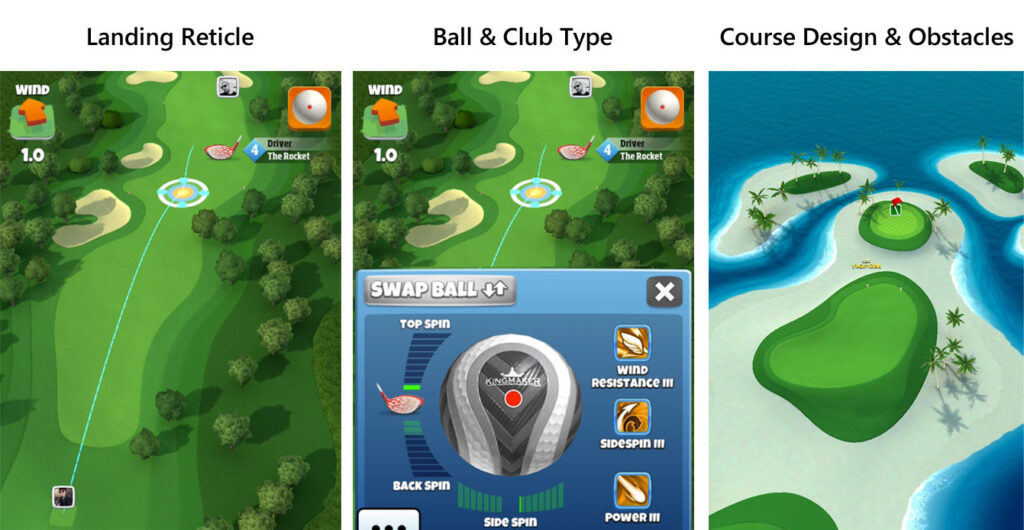
Above: A multitude of factors other than just following the timed precision system can affect the outcome of your shots.
The factors combining together to give Golfclash players a heady mix of tactical and strategic gameplay options are:
- Sling Release Precision: Timing and releasing your shot as per guidance system to have a certain degree of precision shots.
- Players Gear: Club and ball characteristics + any bonuses
- Environmental Factors: Wind, golf course level design, length, varied obstacles, water hazard, surface friction dependent on the surface type the ball lands on: fairway, rough, sand pit etc.
These factors not only add a lot more decision choices for the player but also help make the gameplay more fun and diversified for a casual gamer.
Best part is the game does not expects you to learn all this upfront, you learn either by trial and error or through a peer tutorial as we will learn ahead.
PvP Experience
Good matchmaking algorithms (MMA) lies at the heart of any strong PvP based games. Golfclash does a good job of ensuring players are relatively evenly matched based on their skill and experience in the game. From my experience there is a 50-50% chance of getting a player against whom you may win or lose at least in early gameplay, which avoids griefing for players who are way down the ladder. But these odds may changes as you become an advanced player.

There are different progressive tours that can be unlocked via the trophy system. All of them have a progressive entry fee or wager that you have to pay in coins – which is one of the two in-game currencies. In return, winning a game doubles the coins you disbursed for entry and will also increase your trophy count.
If players lose too many games in a row, they lose coins and potential chests that replenish the coin supply. Leaving them cash strapped, this acts as an invisible energy mechanism restricting players from playing the game indefinitely.
As with so many other games, trophy count is like your overall ranking and winning increases this rank to unlock new tournaments where stakes are higher. One can’t farm beginner tournaments forever as they tend to yield a maximum of 20 trophies.
Psychology of Wagers:
Wager mechanics can also be found in other sport simulation games like 8 Ball Pool but its real origin lies with casino games where each table or slot machine has a different amount of wager needed as an entry fee but progressively higher tables with higher entry free offer higher rewards or returns.
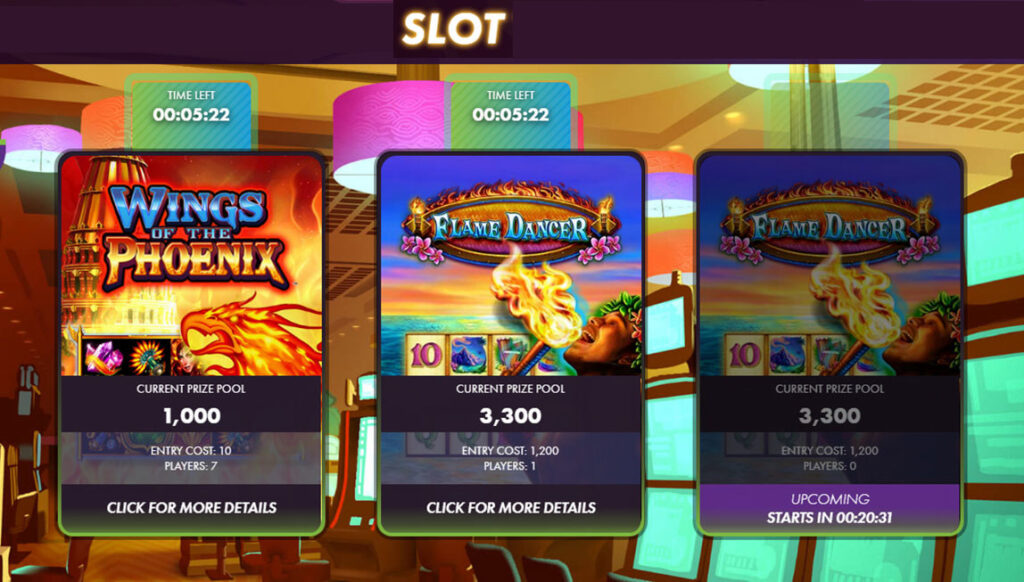
Progressively higher wagers promote ‘high risk, high reward’ decision making which have been cornerstones of casino games & stock trading. But wager mechanics can also frustrate a majority of casual player and act as deterrent to their progress.
As postulated in classical economics theory, when we talk about wagers we are also talking about people’s natural preferences toward risk, which greatly differ individual to individual.
- Risk Averse/Averters: Individuals who seek to minimise risk. Majority of individuals generally prefer the less risky situation (that is, the situation with less variability in outcomes or rewards).
- Risk Seekers/Lovers: Individuals who prefer taking risks
- Risk Neutral: Individuals who are indifferent toward risk
How this may apply to Golfclash or any other wager mechanics based system?
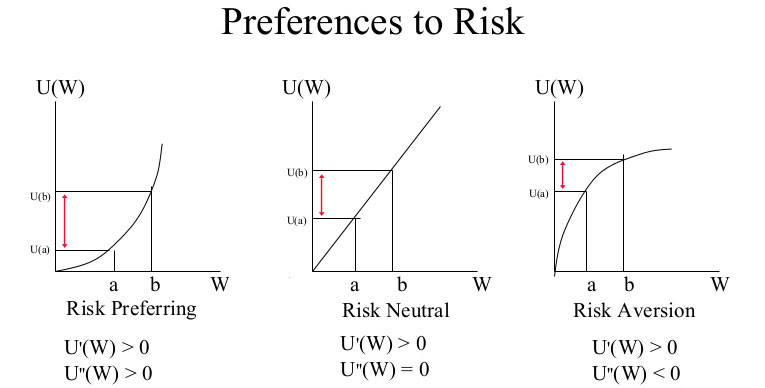
Risk preference is measured by the utility players get by promised increment in their income as shown in the curves above (Y axis represents utility, X axis income from progressive wagers) . Comparing the curves above for risk preferring individuals, the marginal utility (difference between U(a) and U(b)) is much higher compared to risk averse person for the same amount of income gained (a to b) via progressive wagers. This may leads them to indulge in high wager levels but the risk averse person may prefer to stick to playing low wager levels as the utility gain is lesser.
Risk averse players will likely stick to lower tours and play it safe, as losing one or two games in a high entry wager tour can significantly affect your fortunes (coins) preventing them from playing anymore. For risk averse players, utility received from a chance of earning high reward/payoff in high stakes tour is less compared to utility received from playing multiple low stakes tours in one session. So in their case, strategy will be to minimise losses in order to take part in more tours per session or per day. In short, chances of replay ability of lower levels per session or per day, trumps lucratively high payoffs offered by high stake tours.
Risk lovers are high rollers and will be incentivised by high entry barrier to try out new levels and make each level count. Given the high level of skill needed with high wager rewards, this also helps drive people through the monetisation funnel. For players, the utility received from a high wager tour’s high payoff reward will be greater than utility of loss of coins or replay ability per session or per day.
Risk neutral players will not bother about either the risk of high reward or the chance of replay ability. Their utility is neutral as far as wagers are concerned.
Hence even though wager mechanics can act as a high deterrent for majority of players – from trying out high entry levels/tours economic distribution based on established risk preference norms – will ensure there are enough players or high rollers who will keep progressing despite the high stakes. High rollers may naturally, if not exclusively, be more inclined to spending on IAP’s as seen in player behaviour in casinos and stock markets around the world.
Countering Risk Aversion Behaviour :
Given that risk averters form a large part of general population which also applies to games player base, there are still ways to counter the adverse effects and making the experience better. For example:
- Increasing the amount of daily coins you receive from the game: Through daily free chests, other chest drops as players open new tours and levels up. This helps remedy, to an extent, the coin scarcity scenario that players might be wary of avoiding at least for the next subsequent tour. As an example: an average risk averse player with coin balance of 4000 may not want to take part in a 3000 wager tour butmight want to take his chances in a 1000 coins wager tour if he knows his supply of coins from daily chest and rewards can ensure it is sustainable and will also afford replay ability of 3-5 games per session even if they loose 2-3 games in a row.
- Making wager currency exclusive: Risk aversion is also compounded by the fact that players need wager coins to upgrade their clubs as well, therefore hoard currency for upgrades. Having a separate currency for upgrades or direct gem conversion, instead of a 2 step process, might help mitigate this pain point.
Learning from Competition: Uniquely putting you in your opponents shoes!
When it comes to on-boarding and discovering new features of the game, Golfclash seems to have an unsaid advantage because of how its synchronous turn based gameplay is set up.
From a UX perspective, Golfclash’s on-boarding & feature discoverability is a subtle nudge & players may not even notice it until…
Since the camera angle, gameplay choices and view of the game for both you and your opponent is almost identical! while awaiting your turn you get to be exactly in your opponents shoes and get to see first hand what decisions, tactics and strategy your opponent is applying to optimise their shots and win the game.
Putting you in your opponents shoes while awaiting your turn acts not only as a great on-boarding & progression tutorial but let’s you optimise your gameplay learning from your opponents good and bad choices.
How it helps players in 2 ways:
1) It helps you learn the nitty gritties of the game which you might not have discovered or bothered to experiment with (true for a lot of casual players). A peer-led (opponent) preview helps discover and understand the impact of a decision which acts not only as a non-intrusive organic tutorial loop for casual players but also encourages you to try out features of the game which may not be very apparent upfront, example below:
Observing your opponents moves while awaiting your turn
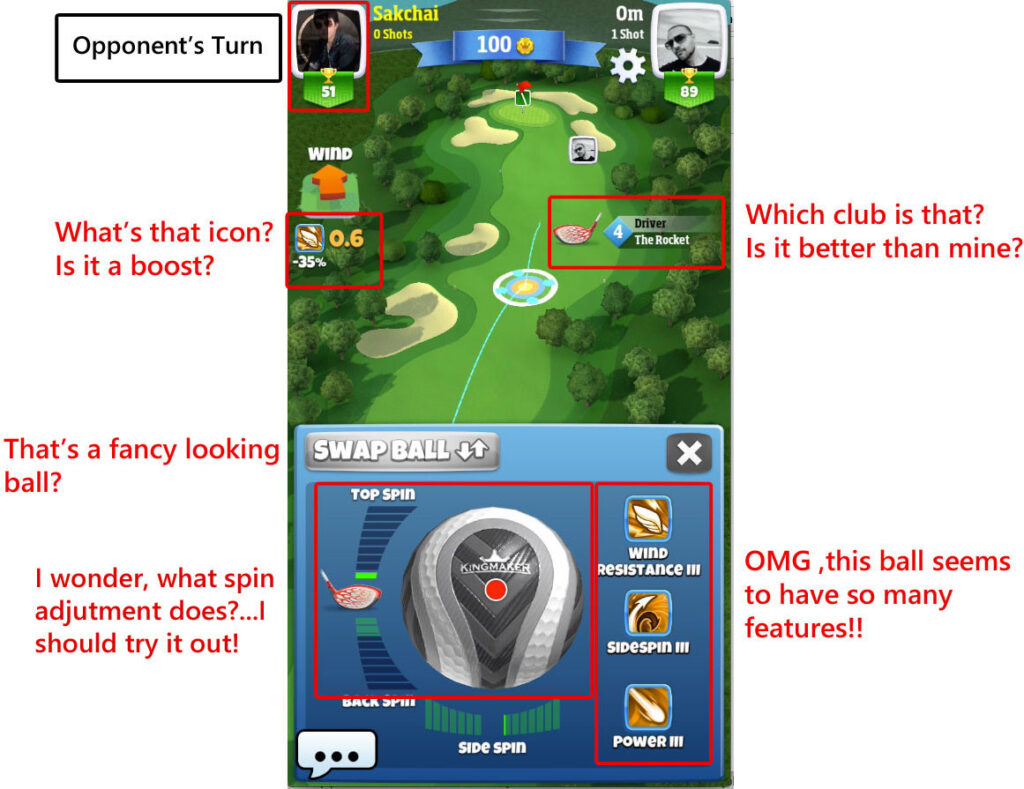
- Seeing your opponent choose and select a different ball and adjusting its spin, makes you wonder if you should do the same.
- Seeing which club your opponent is using makes you think again about your own choices – is the club giving him/her any extra advantage?
- Opponents gear may have bonuses applied that make you think – why you don’t have them? How to get them?
2) Due to the nature of gameplay, both competing players have to follow more or less the exact same steps and path through the course to pot the ball and succeed. This leaves enough room to learn from each other with the ability to get a peek into your opponents mind.Example below:
Observing your opponents decision making while awaiting your turn
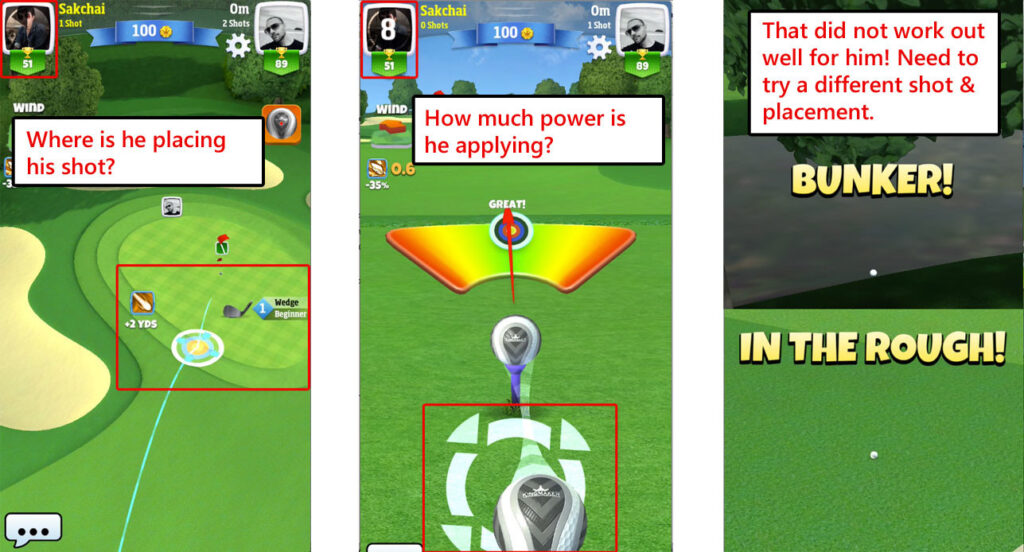
- Where is your opponent placing his landing reticle? How is he trying to overcome the obstacles in the course?
- How much power is he applying? What kind of shot is he thinking of undertaking?
- Seeing the outcome of his shots (especially if you go second in your turn), can help you optimise your own strategy in terms of avoiding wrong decisions. If his/her shot ends up badly (ball lands in a rough patch, or a sandy pit) or maybe optimising your shot parameters to do better than him/her if it goes too well.
NOTE: You may argue that this kind of learning also happens in other games. Yes, but not to the extent it happens in Golfclash. In PvP games like Clash Royale or Hearthstone, you do not get to see your opponents deck or rate at which his elixir is charging. Most opponents decision choices are not exposed. While there will still be some partial learning, due to the fact that player is busy managing both his own game and watching his opponent response, it lacks complete immersion as it happens in case of Golfclash.
Clean, bold, readable UI
Even though it does borders on almost being in your face, big chunky fonts and clean bold graphics make the readability and ease of use on mobile quiet clear and straightforward. This also helps older players of this genre or Golf in particular as older demographics are more likely to have eyesight issues. Even with too many drill downs, the big fonts and clear CTA’s help make the menu accessible and UI readable.
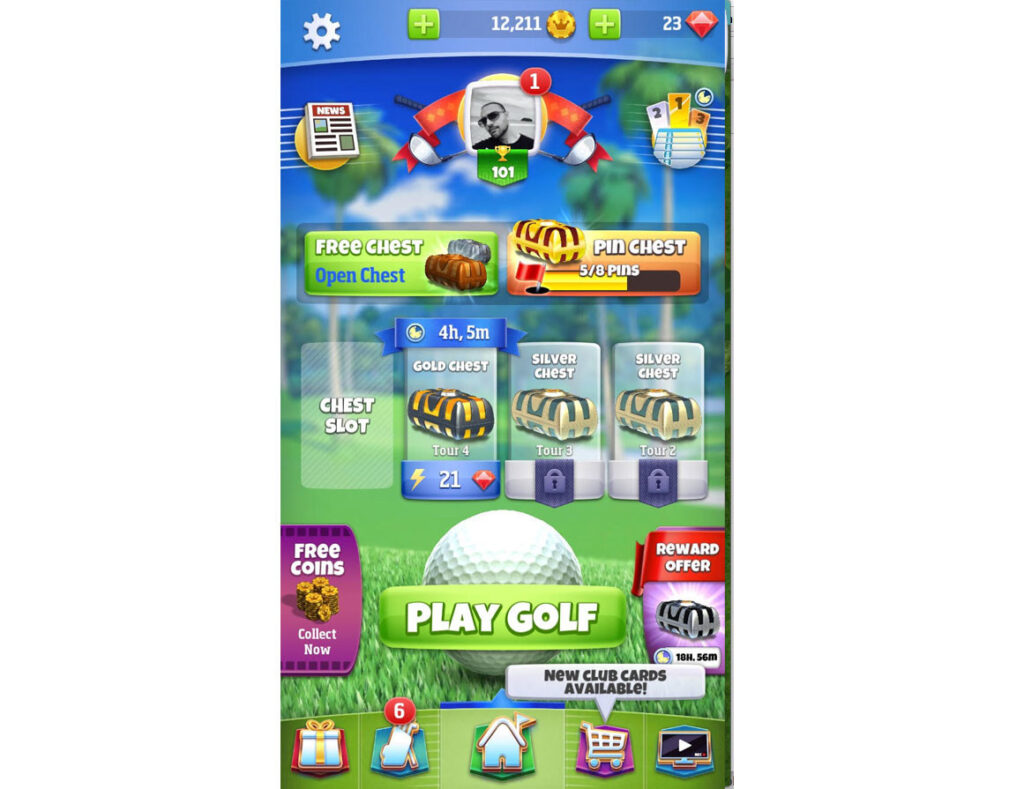
But over time UI can get crowded and in your face!
Downside:
As the game evolves and more features are added, UI space can become crowded and claustrophobic which I can already see happening as player makes progress. As a player progresses, new features like leagues, guild etc. may be added. This creates choice biases and paralysis for the players as they may not know what to do first or prioritise. Reducing the size of elements (relatively) may not be a bad idea for future proofing as it will also help reducing the in-your-face feel of the UI.
Monetisation loops & timed chests
- Wager System, as discussed above, fuels competition as each player needs to wager a pool of their coins to take part in progressive divisions/tours and winner takes all. This allows players to balance risk and reward. Tours with higher wager have more experienced players and difficult courses and games to face, but the rewards are higher too. Unlocking a higher tour creates an appetite and need for more coin sinks.
- Timed Chests are a relatively new concept as popularised by Clash Royale in the western mobile market. Instead of instant gratification by allowing players to open the chest immediately, players have limited slots that require an unlocking action, then wait for 2-8 hours for a chest unlock to happen. Player can also speed up the unlocking by paying gems. Golfclash has the exact same system for rewards.
Reasons why timed chest reward mechanics is catching on
And why it might be compelling to different player types from an economic perspective:
Price Elasticity of Demand Curve (PED) : Is a measure used in economics to show the responsiveness or elasticity, of the quantity demanded of a good or service to a change in its price when nothing but the price changes. More precisely, it gives the percentage change in quantity demanded in response to a one percent change in price.
Price elasticity of demand curve : Effect on NPU’s
Non-paying users are price sensitive, not content sensitive.
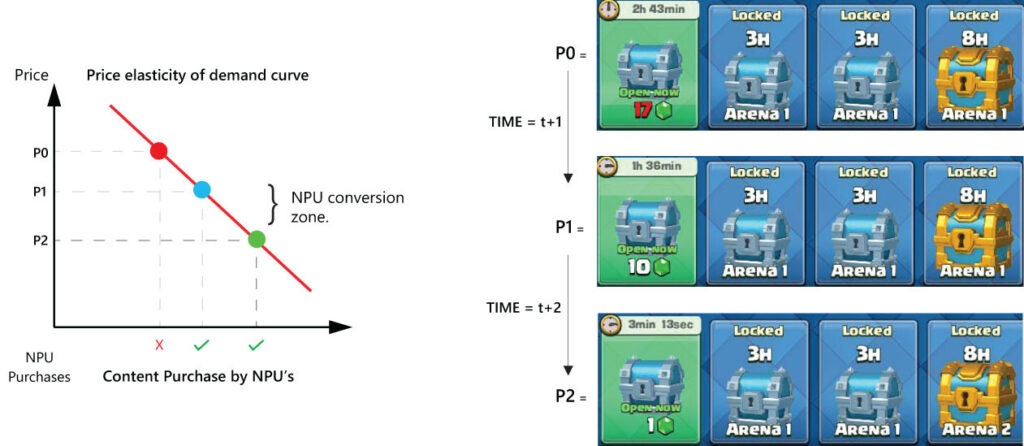
Price elasticity of demand (PED) figure 1 above shows the relationship between price and quantity demanded or purchase decision. NPU’s are extremely price sensitive & responsive to price elasticity. We can see above (right image) P0 (17 gems) is the initial chest opening price at 2hours 43minutes, but as time passes a discounted price P1 (10 gems) is offered at 1hour 36minutes and so on – P2 (1 gem) at 3minutes 36seconds. This increases NPU affordance to spend gems and open the chest as time passes leading to higher conversion. So non-paying users who are averse to spending money on unlock have a higher propensity to wait and spend a smaller fee on unlocking chests as time passes instead of paying a big fee upfront. This creates conversion opportunities for NPU’s and hence help create premium currency sinks.
Price (in)elasticity of demand curve : Effect on high spenders & whales
Purchase behavior from data based on games similar to Game of War, Clash of Clans etc. and behavior of non-paying users and high spenders suggests that:
High spenders or whales are content sensitive, not price sensitive.

High spenders like to acquire new content fast and quick, irrespective of the price. This makes the price elasticity curve quiet inelastic for high spenders as they will make purchases even at higher price tiers to progress faster compared to NPU’s who are quiet price elastic. We can see from above that the curve has become quiet steep & inelastic implying high prices are not a deterrent to purchases relative to NPU’s. This combined with FOMO to manage chest slot inventory creates higher premium currency monetisation sinks.
Timed chests also act act as reactivation and re-engagement mechanics. They avoid stacking or overt hoarding of chests thereby preventing players from becoming immune or dis-enchanted with chests due to sheer volume and frequency at which they drop forcing players to unlock timely and keep their chest slots empty, else they miss out on any chests they will win from subsequent games.

Conclusion
Golfclash has really taken sports simulation games category by storm. It is perfectly poised to be a game that has broad appeal to both casual and mid-core players. At first glance it seems like a Clash Royale wannabe, but at its core lies very accessible and an addictive gameplay.
- Gameplay trumps Golf as a sport!: Given the heady but subtle mix of diverse gameplay factors from sling precision system to environmental factors to investment in gear upgrade, I am convinced that even if we strip out golf and use this combination with any other sport or genre, players will still find it delightful. The gameplay design elevates itself above the sport – and there are some really good gameplay elements here – from which other casual and mid-core games can benefit.
- Highly effective peer on-boarding: As covered in detail above, I am sure this did not happen deliberately but given the gameplay design which maintains the same camera angle and homogenous decision choices in order to succeed in a PvP match. Total immersion devoid of any distractions which a player awaiting his turn has to pay to his opponents moves and tactics, with all of the opponents decision choices exposed, is a great learning resource both for discovering more features of the game as well as spot optimising ones gameplay against the opponent.
- Wager system can feel detrimental to progress for many players: As explained in terms of risk preference propensity of individuals, many casual players may find themselves deliberately sticking to lower low-wager tours and playing it safe in order to maximise their utility of replaying the game as opposed to the risk involved in losing and becoming cash strapped by taking part in high wager tours. However with risk aversion counter-measures like ensuring players have increased flow of coins from free chests and regular chest drops as they progress can remedy the issue to an extent.
As Golfclash continues to tread along the road of enticing both casual and mid-core players, it will be interesting to see which new games are inspired by it and begin a genre war to rise to the top in 2018!